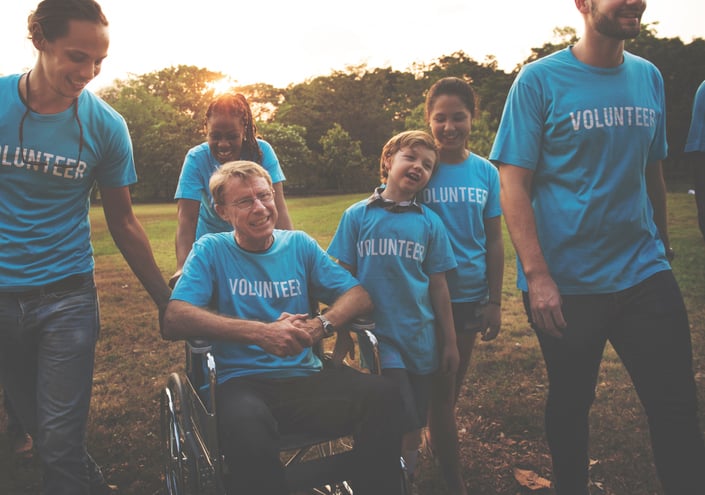Want to increase volunteer retention? Here’s how to do it and enjoy the process.
It’s start the New Year by taking a show of hands. How many of you subscribe to this belief?:
“Creating a strategic plan for a volunteer program is a waste of time. It’s an abstract document created to please leadership and destined to gather dust on a shelf.”
I imagine I’m seeing a lot of hands raised for this virtual poll. In volunteer management, where we are doers who spend our time getting things done, it may be hard to believe that creating a strategic plan is worth the time spent to create it.
Even if your team begins the process with a lot of energy, how do you motivate your team to keep going as other demands eventually take priority? And is it even worth the effort?
It’s Doable — Here’s Proof
The short answer is yes, and here’s the example to prove it: Henrico County Court Appointed Special Advocates (CASA) created a volunteer engagement strategic plan and is faithfully following through with it. And less than two years in, the team is already starting to experience positive results.
Jeannine Panzera is the leader behind Henrico CASA’s strategic plan. As program director, she oversees a staff of five who support more than 100 volunteers who advocate for abused and neglected children in the juvenile court system.
It’s a very specialized role, requiring volunteers who are skilled in research and report writing, have great interpersonal skills and strong boundaries. Plus, they must commit to staying on their assigned cases until they’re closed by the court – a process that often takes a year or longer.
One more thing: as with almost any position, CASA volunteers become better at advocacy the longer they do it. While that’s preferable from an operational standpoint – less recruiting, less new volunteer paperwork, less initial training – it’s also critical for the CASA mission. A CASA volunteer’s advocacy helps ensure that children ultimately find safe and permanent homes. It’s a volunteer role with the potential to change the course of a child’s life.
The Process
Knowing that the stakes are high for the children they serve, Jeannine and her team approached the strategic planning process with the ambitious goal of increasing average volunteer retention from 3.5 to 5 years.
Now, after only 18 months of implementation, Henrico CASA
volunteers are staying an average of 4.3 years.
There’s nothing magical about this achievement. Jeannine and her team are experiencing results because they know that committing to the strategic plan will help them realize their goals.
Here are the elements behind their success:
Focus on the Basics
Jeannine and her team based their strategic plan on three priorities that align with the traditional “three Rs” of solid volunteer management: recruitment, retention and recognition.
“I like to call them the ‘Triple Threat,’” says Jeannine. “While retention is the ultimate goal, we know that’s not possible unless we recruit the right volunteers to fit the position and supervise them properly.
“We want to make sure we are doing our absolute best to bring in and motivate the best volunteers.”
Once the team landed on these priorities, they established the strategic planning basics:
- A set of goals and objectives for each priority
- Action items to achieve each objective
- Dates for action item completion
Each action item is assigned to one member of the team, who ensures its completion.
“We all share ownership of the plan,” Jeannine continued. “The staff chose which action items they wanted to spearhead. Sometimes a staff member chose an area that was new to them. This gives them the opportunity to try something new, to stretch, and be challenged.”
Work the Plan in Stages
The strategic plan works because it’s realistic. The team expects to fully realize the plan in three to five years, taking a step-by-step approach to the goals.
In these first 18 months, the staff have focused on two strategic projects that will inform their work moving forward:
First — An Ideal Volunteer Profile. To improve retention, the team wants to understand what their 5+ year volunteers share in common: their age, level of education, professional experience, marital status, experience with children, etc. The goal is to create a profile of an “ideal volunteer” to assist with marketing and screening purposes.
“We’ve already started to use this information to target our recruitment efforts,” Jeannine observes. “For example, we now direct our marketing efforts to groups that our longtime volunteers are affiliated with, such as corporations and military veterans.”
Second — a Volunteer Motivation Study. The team is using a survey, The Functional Approach to Volunteers’ Motivation, to gather data on the motivational styles of their volunteers. The goal is to use this information to tailor supervision and recognition efforts to the individual needs of the volunteers.
For example, many of the volunteers value recognition from the professionals they work with. As a result, the team has created a system where judges, guardians ad litem (GALs) and social workers will send personal thank you letters to volunteers on their cases. Volunteers who serve 10 years or longer will also receive a special thank you letter signed by all of the judges on the bench.
Commit to Having Fun
For Jeannine, it’s essential that staff enjoy the strategic planning process. “We began this project with an offsite weekend retreat on the river, Jeannie explained, “It wasn’t all work. We did fun stuff like swimming, kayaking and playing games to relax and encourage creativity. Then, we worked on strategy as a group, with individual members taking charge of various parts of the plan.”
Now back in the office, the team holds monthly meetings to review the plan and discuss next steps.
“We meet for about two hours – and we still make it fun. The team gets together around 12:30 and brings a dish we can share. We’ll spend some time catching up. And then we dig into the plan. Keeping the meetings fun but focused helps to keep us excited about the plan. It’s our common project – something that binds us together.
“We know the strategic plan will make our jobs easier. When our jobs are easier, the whole system benefits: the judges, the GALs, the social workers, and ultimately the children. At the end of the day, everything wraps back to the mission.”
Editor's Note: Looking for more tips on how to develop a strategic plan for your volunteer engagement program? Sign up for our free "Developing a Strategic Plan for Volunteer Engagement" training!
Guest post by Elisa Kosarin. This post originally appeared on Twenty Hats.




